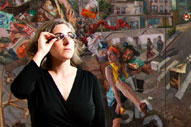 "Art doesn't transform. It just plain forms." - Roy Lichtenstein.
"Art doesn't transform. It just plain forms." - Roy Lichtenstein. Dedicated to making the arts a community pillar for Macomb County is Dr. Jennifer Callans, executive director of the Anton Art Center. This week Jenny will open the discussion on arts funding, programming, and the art community's changing demographics.
Post 2: It Takes a Community to Stencil a Storm Drain
Posted By: Jenny Callans
Posted: 12/17/2010
A great many art centers - including the Anton Art Center - were founded in the 1960s and 70s by volunteers who wanted better access to the arts, right in their own communities. Cities and townships have often donated or loaned buildings to these groups so that they'd have a physical home. Because all those involved understand the value of an art center -- and the arts in general -- in building a cohesive community.
Or, at least, that's the theory. Because the other side of this coin is all the people who walk through the center's door looking for the Mount Clemens Public Library (which moved in 1967), or who find their way into the center and say, "Wow, I never knew this was here!" (The Art Center was founded in 1969 and is on a very visible, high-traffic street corner).
But even those who don't know about their nearest art center benefit from its existence. The Anton Art Center, for example, runs a youth leadership program in partnership with our local school district. We run Healing Arts classes at three area hospitals. We administer the city's Art in Public Places program, maintaining several sculptures placed throughout downtown.
Much of the Anton Art Center's programming is typical of art centers in general. As community-based institutions, usually serving a county or a portion of a metropolitan area, art centers are part of a movement that takes multiple perspectives, multiple voices, and unites them into one whole. Few fields are better than the arts at integrating disparate factions, or if not integrating them, then getting them to understand each other's points of view.
But this doesn't happen overnight and it takes engagement with the community, and support by the community – time and money.
Take a simple project at the Anton Art Center: storm drains "Dump no waste; drains to river" and decorating them with aquatic life. This requires paint and brushes, stencils, and some paint smocks. The project is done in the street, so we need traffic cones and reflective vests for protection. Fliers have to be delivered door-to-door so that neighborhood residents know why there are groups of people out painting the street. If it happens to be hot the day of the painting, we try to supply water and snacks.
A guerrilla arts group would just go out and stencil the drains. But being a symbol of the community means toeing the line sometimes, and that's not a bad thing. Because then the people of that same community stop by to admire the work everyone's doing, or someone brings out a plate of cookies to pass around.